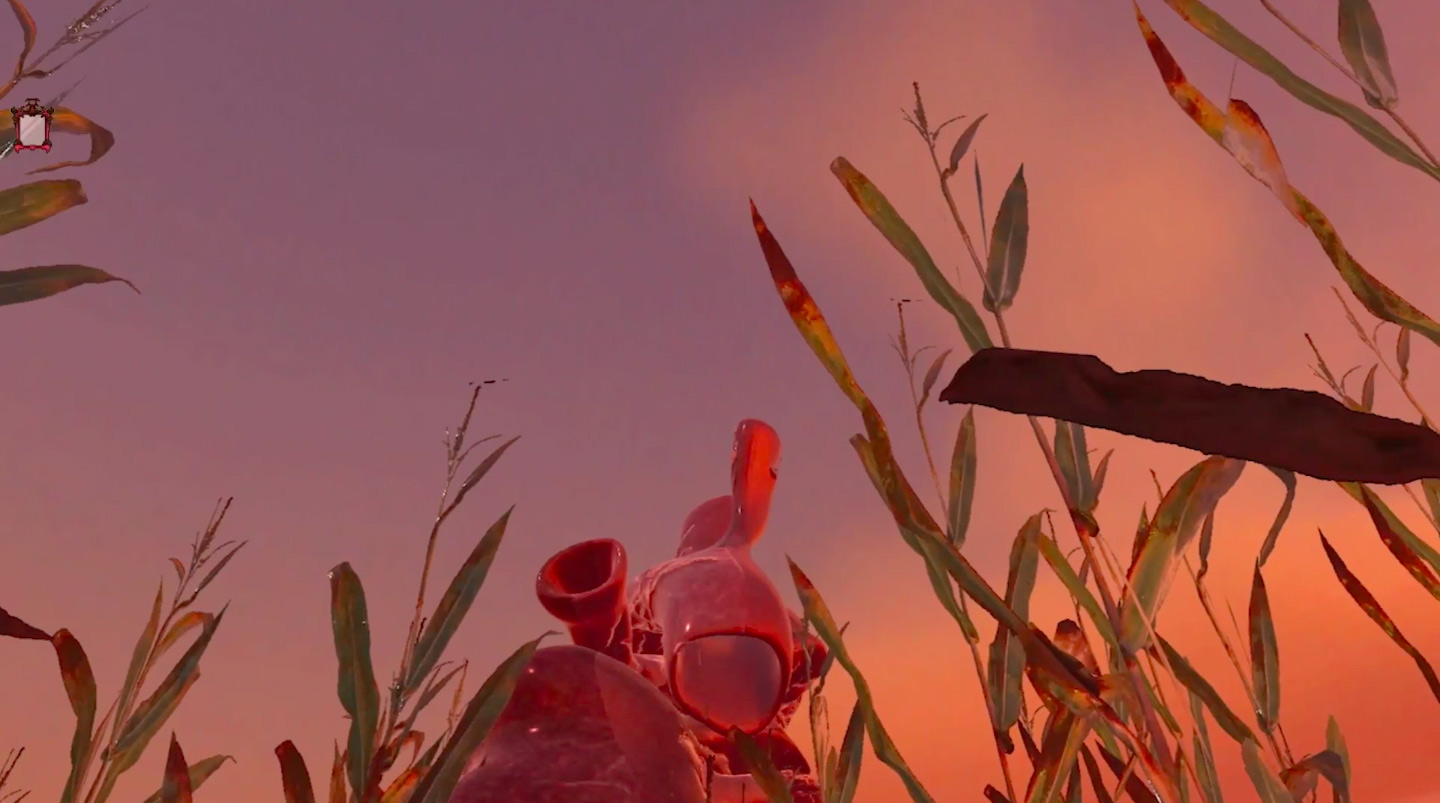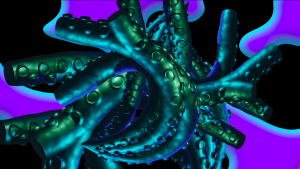
ETHEREAL THRESHOLDS AND SURPLUS AESTHETICS
Word Count: 4,052 |
Download this article
by •
008: ETHER
with DEAR ONE, DEAR DEAD
an artwork by LÉA PORRÉ
Abstract: Non-Fungible Tokens (NFTs) are units of data stored on a digital ledger, the blockchain, that verify a digital asset to be unique. The aesthetics of NFTs play into notions of surplus pleasure, running parallel to cryptocurrency’s accelerationist and theological undercurrents. Artists are presented with a new set of philosophical, ecological, and politically charged challenges, in which notions of temporal transcendence and the desire for salvation are being reconstituted. Crypto art is by nature superfluous, it is an excess of imagery via digital labor that is bathed in cosmological, eschatological, and sub-spiritual associations, with its overarching emphasis on a limitless technological singularity—an explosion of runaway superintelligence. For all their decentralized, deterritorialized, and anonymized glory, digital currencies run the risk of reinforcing and exacerbating existing inequalities. Despite the shortcomings, we have every reason to remain engaged and affronted by these ongoing developments.
Is anything more theologically seductive than a resurrection? Better still, a “Transfiguration”—as evidenced in Postmasters Gallery’s 2021 summer exhibition, peppered with Non-Fungible Tokens (NFTs), and braced by a subtitle that tells us the art is “leaving reality behind.” For those just waking up in 2021, NFTs are units of data stored on a digital ledger, the blockchain, that verifies a digital asset to be unique. The artworks convey a sense of estrangement through congealing veneers of past and present—speculative visions of a supernal future to come, replete with transhuman avatars and celestial motifs. Alessandro Giannì’s Ahead (2011) is a case in point, with an image composed of tanned men in pyramid formation, reminiscent of Elon Musk’s conjecture of humanity as a “biological boot loader” for artificial intelligence to prosper. Each figure wears identical black trunks, uniformly ascending in a desert landscape. Insert tech overlord du jour at the top.
This show could alternately have been titled “Transubstantiation,” in which physical artworks, as Julia Friedman and David Hawkes put it, are “reborn into a financialized afterlife where it is no longer subject to mortal decay.” SuperRare, an auction site for digital artwork powered by Ethereum, has curated a similarly titled group exhibition “Un-realism: Bridging the physical and digital realms,” wherein shared issues are in play. NFTs corralled in these shows tend to ooze with innuendo, interbreeding familiar sci-fi tropes with low- and high-tech visual acumen. Press releases touting crypto art typically adhere to unvarying terms and ideas, as the “real and imagined” are churned into works “blending fluid identities” to form “futuristic landscapes.” When observing this work, critics and viewers can generally call upon a number of charged, antagonistic adjectives: chaotic, kitsch, abject, puerile, nasty, crass. They are indeed an acquired (and acquisitional) taste, radiating repetitive effects and affects.
NFTs are leveraged to mobilize the creative labor of others. They are low-risk merchandise and hyperbolic revenue raisers made in a digital wilderness, slowly building toward community-driven liquidity. The only difference between looking at an NFT and buying it is the certification of ownership and authentication (vis-á-vis a chain of digital signatures), which is encrypted through blockchain technology. The collector purchases, then owns a unique asset residing in their digital wallet, and the artist retains the original raw data of the file. Artworks have built-in tracking ledgers by which online artists can claim royalties on sales. In spite of this benefit to artists, NFTs are commonly regarded with suspicion instead of curiosity. Anil Dash, one of the earliest conceivers of these “monetized graphics,” has been vocal about the pitfalls and shortcuts of crypto art platforms, many of which still depend on third parties for verification and reside on pre-blockchain domains. That said, it would be premature to dismiss NFTs as already forsaken byproducts of tech-bro culture, particularly when so many artists are drawn to the medium for its subversive mystique. The blockchain’s philosophical pliability and Bitcoin’s dark web foundations have an anarchic appeal, even as it absorbs its fair share of sellouts. As accelerationist provocateur Nick Land says in Crypto-Current:
For the “hyper-libertarian” Ultras, Bitcoin is a soft weapon aimed unambiguously at governments and their subsidiary institutions. … The important point is that Bitcoin provides a route-around. It was the first native currency of the dark net. The Open Secret, or ledger of crypto-secured transactions, supports rigorous commercial commitments without penetrating social exposure, or endorsement. … The things Bitcoin enables are exactly the sort of things “secret agents” want regularly to do.
Common tech-bro knowledge will inform you that the value of most NFTs will ultimately drop to zero and that most platforms aren’t built sustainably. Bitcoin maximalists will tell you that Bitcoin is the only legitimate platform—that the other crypto currencies are casinos with no value. Altcoins—that is, cryptocurrencies other than Bitcoin such as Ethereum—are the blockchains and currencies through which a vast majority of crypto art is transacted. Even with the recent sharp decline that the major cryptocurrencies have endured in recent months, following the stimulus check-boosted peak in 2020 and February 2021 (around the time Beeple mania at Christie’s went down), most investors understand the volatility of each currency and plan to park their assets in crypto while keeping the long view, ignoring short-term market fluctuations. One of the co-founders of Ethereum, Vitalik Buterin, argues that Bitcoin is not safe from quantum computer break-ins. As Arthur Herman observes, blockchains could become just as vulnerable to cybersecurity threats as regular web browsers and VPNs, and will require upgrades to public-key cryptographic systems, post-quantum cryptography, post-quantum secure blockchains, and ledger technology that relies on quantum computers.
Daniel Krawisz, Director of Research at Satoshi Nakamoto Institute, is highly critical of altcoins as pointless knock-offs deviating from the primary purpose of the blockchain. Krawisz claims that ether users pay for the computational effort required for transactions vis-á-vis “gas fees,” with two units instead of one monetary unit: “You have two proto-moneys that are competing against each other, so that makes Ethereum like a house divided against itself.” Krawisz has no faith in the proof-of-stake model that Ethereum espouses and wants to resist the murky territory of Initial Coin Offerings (ICOs), the cryptocurrency world’s equivalent to an Initial Public Offering. Instead, Krawisz, a Nakamoto purist through and through, aims to build on a sustainable currency that can be scaled up worldwide:
What is a cryptocurrency actually for? I say that its purpose is to become money. It is obvious that creating altcoins impedes that purpose. Altcoins can only be explained if we believe the purpose of cryptocurrencies is to make money rather than to become money. If you can trick people into investing in your new altcoin, then you can make a profit trading it or mining and selling it. All the arguments of the altcoin promoters serve as misdirection from that basic purpose. They have developed a series of fallacies capable of fooling newcomers into joining them, but they are all disingenuous.
Bitcoin began as a game-changing money (and trust) replacement, so the art market must contend with the “make money” versus the “become money” conundrum, while being confronted with an abundance of images that fly in the face of taste, exclusivity, and elitism. A New York-based art advisor, Vasili Kaliman, tells me that the upper echelons of the art world will not take on NFTs in full seriousness until a heavyweight like Maurizio Cattelan or Richard Prince or Tino Sehgal release a body (or banana with duct tape) of work that blue-chip galleries can rally around. A common mistake the art world makes, Kaliman tells me, is to think of NFTs as editions or screenprints: “Nobody is interested in that. The trading card industry understands NFTs. You’re creating a collectible, not an edition, and creating a community to gravitate around it. It has to be the same but unique, like Warhol’s society portraits.” As far as New York’s art scene is concerned, Postmasters Gallery and Superchief, and online platforms such as SuperRare and OpenSea, are among the frontrunners of crypto-art commerce and curation. As with any medium and gallery, they have mixed results.
In Postmasters Gallery’s “Transfiguration,” José Carlos Casado’s “inside.v07” (2002) is a simple 3D animation featuring two bald, sand-skinned, androgynous figures in a kiss that appears to consume the boundary between their faces. These clones simultaneously mirror and devour each other, nodding to René Magritte’s masked lovers, substituting cloth hoods with the veil of animation. “Inside.v07” also recalls an HTRK music video, “Synthetik” (2015), directed by Pussykrew (Ewelina Aleksandrowicz and Andrze Wojtas), another duo featured on the Postmasters blockchain. Since that sultry analog music video, Pussykrew have continued to experiment with cyborg characters, real-time animation, photogrammetry, 3D, and VR sculpting. Their metallic and neon palettes present hyperreal world-building with mythological demiurges and augmented bodies.
While not distributed via Postmasters, Pussykrew’s recent collaboration with Peaches is a gaming experience titled “Fill the Whole,” featuring a variety of avatars and candy-colored terrain guiding the user to an elaborate warrior-goddess, Durga-like shaman who leads a meditation, expounding self-love and goodwill to all beings. In a way it’s very twee, but you have to take into consideration the generation of disaffected youth that this is made for. Pussykrew’s constructs are intentionally non-binary, devoted to queer virtual spaces while tapping into emotional angst and defiance against their native Poland, one of the most homophobic countries in the European Union. The player-avatar is guided through terraformed landscapes occupied by monstrous sculptures of decapitated autocratic heads. A rotating diamond-shaped object suspended in the air resembles the octahedron Ethereum logo—ornamentation meets objet a—contained within a bonbon dystopia of society on the brink of collapse. If there’s any language that the digital sphere understands best, it’s gaming, and this is a game of positive reinforcement, in which the journeying user scores heart tokens as rewards.
SuperRare’s “Un-real” exhibition is no less whimsically apocalyptic, its mythological tone set by Federico Clapis’s 3D-rendered sculptural work titled “End of the Physical World,” showing a baby carried aloft by a drone instead of a stork. “A new world begins, in which the apparent solidity of matter is now a distant memory,” declares Clapis, summarizing the piece. Other artists take slightly more jovial approaches, such as Jonathan Wolfe’s digitally edited acrylic painting, “the wizard,” which depicts a man sitting merrily drunk amidst empty shot glasses and an inebriated Pepe the Frog. The rapid turnover of weekly offerings curated on SuperRare’s site certainly favors quantity over quality with go-to issues and themes: humanity’s struggle for survival, resource warfare, and transmutation.
Seldom has there been an image yet in the NFT landscape that is as epic and alienating as the theater of cryptocurrency mining in Iceland, where hundreds of thousands of fans blast cold air to keep machines from overheating, aided by giant ceiling turbines, an infrastructure now using more of the nation’s electricity than its homes. Digital labor is a continuation of exploitative practices, market reification, and dead labor in industrialized society, only instead of an assembly of people, we have crypto miners solving complex math problems to make transactions go through. Given the overarching decline of concrete labor, a vast surplus of people living precariously do not have the conventional money to buy back what capitalism produces, and fewer people contribute to capitalism in terms of profit making, aside from performing as content and intel providers on their devices. Fabio Vighi’s critique of the labor theory of value is instructive here:
[Surplus-value] is the meaningless remainder of the capitalist narrative, rather than a measurable quantity of labour-power. … While Marx resolved the riddle of surplus-value within the context of capitalist exploitation and profit-making, he did not see that the answer to the riddle posed by surplus-value is that there is no answer—surplus-value makes the world tick as the signifier of an impossibility.
Although Marx did not see the counter-economics of the blockchain coming, there is a correlation between Bitcoin and the impasse of surplus-value. Lacan transitioned surplus-value into the realm of surplus jouissance, a pleasure-pain compulsion, distinct from the repetition compulsion of the drive. Joan Copjec extends this aspect of Lacanian thought succinctly:
It is this that Lacan names jouissance; he calls it an “inheritance” of the subject, but not one that can be used up, it is “impersonal” and does not belong to the subject. That is, psychoanalysis realizes through this notion of jouissance or surplus pleasure that the subject belongs to something that precedes it, that is, an ancestry or culture, that gives the subject its potential without that potential’s being a potential for anything specific, without its being a potential for x, y, or z. That which precedes the subject is therefore essential to it, a potential and not simply a limit.
Crypto art is by nature superfluous, it is an excess of imagery via digital labor that is bathed in cosmological, eschatological, and sub-spiritual associations, with its overarching emphasis on a limitless technological singularity—an explosion of runaway superintelligence. For evangelical enthusiasts, the blockchain is The Second Coming: a revelatory and philosophically visionary system that, without requiring tangibility in the real world, is now a part of the world’s essential software, and perhaps an opportunity for humanity’s endurance beyond bodily constraint. The blockchain figures as the next-level substrate in an esoteric society, enhanced by the anonymity of the chain’s Christ-like founder (or founders), consolidated under the pseudonym Satoshi Nakamoto. As Ole Bjerg describes, Bitcoin’s ontological constitution is construed as “commodity money without gold, fiat money without a state, and credit money without debt.” Theoretically the blockchain is a form of holographic computing in which each block in the chain is given an exact timestamp when added to the chain, becoming a unit of simultaneity within which all data across space-time is chained together. The chain creates its own objectivity through peer-to-peer critique, dispensing with trust by virtue of a distributed and traceable server-to-server ledger system.
On the other hand, we have the vehement naysayers who believe Bitcoin foregrounds a recession that will rival the last, a tech bust in which trillions of dollars will be lost down a crypto drain, not to mention all that energy spent keeping the equipment cool and functional at the expense of further warming the entire planet along the way. The point is to stay attentive to both sides, since both will play out in uneven fashion. Regardless of where one stands on the ideological spectrum, artists are faced, conceptually, with a revolutionary paradigm shift, a meta-structure that may be as profound as the internet itself and has vast consequences for the future of governance, and artificial intelligence.
What’s obvious but important to underline is that the symbolic order—including political, economic, and social structures and institutions—is losing consistency. Railing against government structures starts to seem futile in late capitalism because, as demonstrated by Occupy Wall Street, technically, nobody is in charge. What we have in lieu of a definable ruling class as described by Marx are much more fractured and obscure targets: a bunch of corporations and privatized individuals pursuing separate agendas as the equality gap continues to widen and digital assets with a degree of scarcity will continue to appreciate against devaluing currency.
For all their decentralized, deterritorialized, and anonymized glory, digital currencies run the risk of reinforcing ultra wealth and replicating hierarchies of government control, as well as being susceptible to ransomware extortion. Gazillionaire Vladimir Putin supports crypto, since he would count as a benefit anything that undermines US sanctions. An estimated 90% of China’s crypto-mining capacity will soon be shut down amid environmental concerns, a significant fact given that Chinese mines power 80% of global cryptocurrency trades and thus will reallocate mining activity to other parts of the globe. A major part of Venezuela’s crypto operations involves businesses swapping out of bolivars to combat inflation. With Musk dictating the value of Bitcoin and clone currencies like Dogecoin on the whims of his tweets, and Jeff Bezos exploring the launch of its own coin, the Biden administration is proposing more stringent regulations to curb tax evasion.
Nation-state conflicts aside, the question of the blockchain’s capacity for transcendental temporality is an intriguing proposition. As Ben Goertzel and others suggest, we have a lot of creatives creating entropy, an evolutionary process that is wasteful but also transforming how we conceive of the undulations in space and time. Goertzel says: “If you can mint time, by a control over the space-time continuum, then using time wisely has a whole different sense.” Land claims that even if digital dematerialization is only ever approximate, the implications are drastic and concrete. In his account, Bitcoin is more than a currency, it brings us into communication with the hidden gradients of a spontaneously-engineered enterprise, paving way for noumenal conditions of objectivity:
The elegance, or economy, of Bitcoin’s virtual universe is fully consistent with a certain ontological luxuriance, encompassing a population of agents (represented by accounts), territories (wallets), objects (coins and coin-fragments), events (transactions), a consensual history (the blockchain), and—providing an ultimate criterion of reality—matter (computing power). Such tropical frondescence is also ecological. It generates niches, as zones of specialization, competition, and proliferation. As with all cases of techonomic revolution, the result is a “Cambrian Explosion” of unpredictable, cross-stimulated innovation. The very meaning of “species” undergoes escalation. As a side-consequence of its unprecedented ontological severity, or selectivity, Bitcoin triggers a re-population of the world.
This sense of evolutionary opulence and of a “tech-ecological” horizon, opens a can of worms for artists, coders, and engineers alike. Information wants to be free, but people want to be free too, in whatever vaguely intuitive (and sometimes delusional) capacity this freedom entails, hence the fraught fervor for biotech and cryonics led by “visionaries” such as Aubrey de Grey and Ray Kurzweil. Nick Bostrom’s probabilistic argument that we are living in a grandly designed computer simulation—alongside pop culture narratives about forgoing bodily mortality, mingling with machines, beaming our consciousness out into the cosmos, and crossing over into a purely mathematical dimension—does seem like aggregate fodder for psychedelic enthusiasts and nerds (myself included). Even staunch critics must acknowledge what is inherently compelling about this next-level transactional ontology, which in essence automates the nature of truth and value. It doesn’t follow that we need to make a choice between slow or fast, Luddism or accelerationism. It also does not follow that everything under the sun is commodifiable. Humans might be, as Musk and Marshall McLuhan suggested, the reproductive organs of the machine world, but we’re not default zombies if we embrace and internalize Cronenbergian fantasies. There are myriad reasons to remain both fascinated and affronted by this experimental extension of the fabric of reality.
Bjerg, Ole. “How Is Bitcoin Money?” Theory, Culture & Society, vol. 33, no. 1, 2016, pp. 53-72, http://doi.org/10.1177/0263276415619015.
Buterin, Vitalik. “Bitcoin Is Not Quantum-Safe, and How We Can Fix It.” Bitcoin Magazine, 30 July 2013, www.bitcoinmagazine.com/articles/bitcoin-is-not-quantum-safe-and-how-we-can-fix-1375242150.
“China to shut down over 90% of its Bitcoin mining capacity after local bans.” Global Times, 20 June 2021, www.globaltimes.cn/page/202106/1226598.shtml.
Copjec, Joan. “The Inheritance of Potentiality. An Interview with Joan Copjec.” E-rea, vol. 12, no. 1, 2014, http://journals.openedition.org/erea/4102.
Dash, Anil. “NFTs Weren’t Supposed to End Like This.” The Atlantic, April 2, 2021, www.theatlantic.com/ideas/archive/2021/04/nfts-werent-supposed-end-like/618488/.
Goertzel, Ben. “Dr. Ben Goertzel on Artificial General Intelligence.” The Voyagers Podcast, 23 Mar. 2021, www.soundcloud.com/user-850337560-513263744/episode-23-dr-ben-goertzel-on-artificial-general-intelligence.
Ellsworth, Brian. “As Venezuela’s economy regresses, crypto fills the gaps.” Reuters, 22 June 2021,
www.reuters.com/technology/venezuelas-economy-regresses-crypto-fills-gaps-2021-06-22/.
Friedman, Julia, and David Hawkes. “NFTs: The Afterlife Of The Aura.” Athenaeum Review, 26 May 2021,
www.athenaeumreview.org/essay/nfts-the-afterlife-of-the-aura/.
Herman, Arthur. “The Bitcoin Boom And The Quantum Threat.” Forbes, 3 Mar. 2021,
www.forbes.com/sites/arthurherman/2021/03/03/the-bitcoin-boom-and-the-quantum-threat/?sh=18f6197d7431.
Krawisz, Daniel. “Daniel Krawisz on Ethereum.” YouTube, uploaded by Shirish Sarkar, 12 Mar. 2021, www.youtube.com/watch?v=fDCv8ASsvWM.
—. “The Problem with Altcoins.” Nakamoto Institute, 22 Aug. 2013, www.nakamotoinstitute.org/mempool/the-problem-with-altcoins/.
Land, Nick. Crypto-Current: Bitcoin and Philosophy. 31 Oct. 2018, https://etscrivner.github.io/cryptocurrent/.
Murray, Jennifer. “Figures in the Lacanian Field: Reading Literature, Theatre and Cinema with the Later Lacan.” E-rea, vol. 12, no. 1, 2014, http://journals.openedition.org/erea/3947.
Vighi, Fabio. “The Absent Cause: Time, Work and Value in the Age of Coronavirus.” The Philosophical Salon, 4 June 2020, www.thephilosophicalsalon.com/the-absent-cause-time-work-and-value-in-the-age-of-coronavirus/.
Zeiher, Cindy. “Unbehagen: a gallantry with excess.” Palgrave Communications, vol. 3, 2017, https://doi.org/10.1057/s41599-017-0035-y.
DEAR ONE, DEAR DEAD

Dear One, Dear Dead investigates the decapitation of King Louis XVIth in 1793, in light of the worldwide mythological pattern of the Sacrificial King. It develops in three acts, reflecting the three stages of Porré’s fictional Sacrifice: the First Act illustrates the Event of the regicide itself. As it often happens in Porré’s works, she chooses not to explicitly reveal the sacrifice. On the contrary, she inserts a number of elements that, together with the hidden connections to historical documents, assist the viewer in a gradual decipherment of the scene. On a mysterious altar, absorbed by a bloody, apocalyptic atmosphere, the cathartic sacrifice of the King is carried out.
The Second Act of the show is dedicated to the Feast, or the celebrations for the Sacrifice of the King. The event evokes ancient societies’ feasts where facsimiles of the King’s organs, and Royal effigies made of dough, were prepared for all the people to eat during a celebratory banquet. It is a time to celebrate the momentary chaos that announces the return of societal order. In the in-between reality of the scene, the landscape is dominated by a magnificent banquet, whose lavishness, however, cannot conceal the feeling of uneasiness and dissolution evoked by the complete absence of people and the disquieting food on the tables: baked goods in the shape of organs of the Sacrificial King.
The Third and last Act of the show consists of an early-morning dispersion of the fragmented body of the King. Once again reminiscent of ancient myths where the body of divine figures was dispersed across fields, the royal body is scattered across the lands and fertilizes the crops, literally becoming nourishment of his people, satisfying their hunger as he failed to do during his living.
Entirely realized digitally with CGI renderings, Porré’s Dear One is inscribed into her ongoing interests in the recreation of hyperreal landscapes that blur the boundaries between what is real and what is fake. At the same time, her virtual representations and her recent exploration of GIFs and moving images allowed her to institute a clear connection with the realm of early video games, or those spaces where, she explains, “fictionalized history was first experienced by a whole generation.” It is in that same way that Dear One presents the Sacrifice of the King: its tale connects events across centuries, presenting new perspectives on widely accepted historical events. Dear One urges us to be aware of both our past and the history of other civilizations, in an attempt to perceive that cyclical pattern connecting the past to the future, in an infinite wheel of time.
Dear One, Dear Dead is shown here as a video version of the original interactive CGI work.
JC HOLBURN writer
JC Holburn has work published in Art Agenda, The Brooklyn Rail, The Drunken Canal, Fence, Filthy Dreams, Full Stop, Topical Cream, among others. She hails from Australia and is currently based in New York. You can find her on Instagram and Twitter.
LÉA PORRÉ artist
Léa Porré is a French and Belgian artist born in 1996, who graduated from the Royal College of Art (MA Contemporary Art Practice) in 2021, and from Central Saint Martins (BAFA 4D) in 2018. Recent solo exhibitions include: “Versaliae,” Off Site Project, online; “Eternal Returns,” The Wrong TV, online (2021); “Dear One,” Virginia Bianchi Gallery, online (2020). Group: “RCA2021,” Cromwell Place, London, UK; “History of Fantasy,” Everyday Gallery, Antwerp, Belgium; “Everything Forever,” MattFlix, Matt’s Gallery, online; “OUT OF TOUCH,” curated by Hervisions, Lux, online. She took part in Akademie Schloss Solitude / Zentrum für Kunst und Medien’s web residency, “Ghosted” (2018), and the Digital Artist Residency programme (2020).
© Copyright for all texts published in Stillpoint Magazine are held by the authors thereof, and for all visual artworks by the visual artists thereof, effective from the year of publication. Stillpoint Magazine holds copyright to all additional images, branding, design and supplementary texts across stillpointmag.org as well as in additional social media profiles, digital platforms and print materials. All rights reserved.



